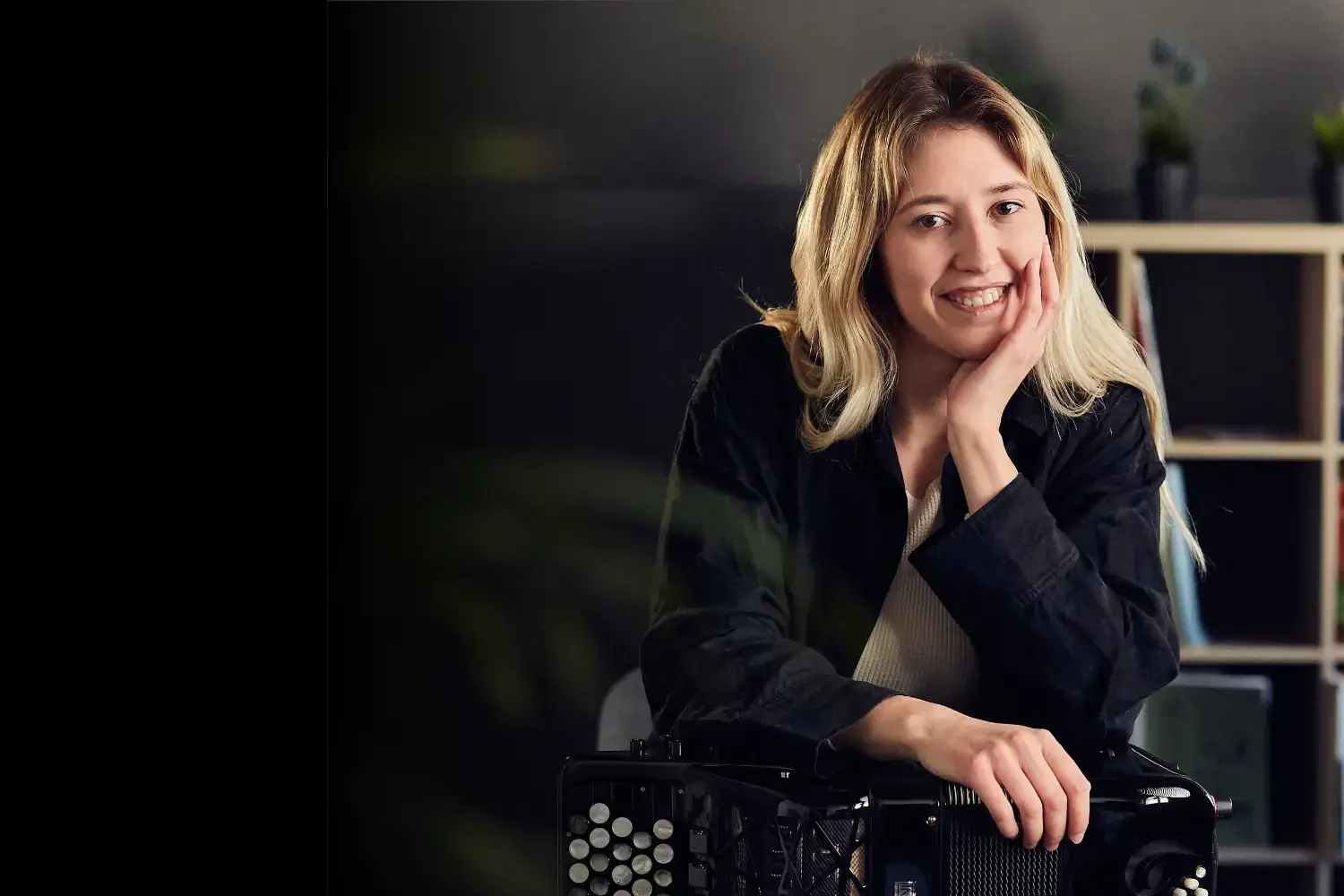(14.01.2022)

You are never too old to start learning the accordion. It doesn’t matter whether there are keys or buttons for the right hand and chord bass, free bass or both, with a converter, for the left hand. Depending on the model, you can play a full gambit of musical styles, jazz, folk, classical and more. Instruments with a converter, where the left hand can play both chord bass or single tones are particularly flexible. There’s something for every taste.
Accordions are available in different sizes, so even small children from around the age of 6 should have no trouble picking it up. It is, however, always a good idea to have a qualified teacher pick out an instrument for you, so that you can be certain that your instrument is the right size.
When you’re starting out, it’s perfectly possible to play by ear, using a fingering chart. Scores for standard bass in the left hand usually also include chord symbols. There comes a time however, where it is a big advantage when you can read sheet music in both treble and bass clef, just like on a piano. It’s perfectly possible to learn this step by step during lessons.
Apart from reading sheet music, it is also important to internalise all the different fingerings for the keys and the buttons, because unlike on the piano, it is not possible to watch your fingers while playing.
Tone is produced on the accordion by vibrating metal tongues, which are put into motion by air being forced past them when the bellows move. The fingers are used to push the keys or buttons on either side of the instrument, and the bellows form the lungs of the instrument, providing the air pressure. The bandoneon and Styrian harmonica.
The accordion is a very physical instrument, so a good awareness of your body gives you a clear advantage. You have to play with your whole body and "breathe" with the instrument. Additionally, the left and right hands must be well coordinated with the movement of the bellows.
The instrument can be quite hefty, so good posture plays an important role in preventing injuries to the back and shoulders.
Anyone who has reached a certain height and is interested in making music and getting to know the intricacies of the accordion is ready. You can make up your own mind as to the musical direction you wish to take. The best course of action would be to try out the instrument in a trial lesson and get advice from a specialist teacher.
Depending on the model and the size, you can get a new accordion for about €650,- new, or used for about €300,-.
Free bass instruments or instruments that are equipped with a converter are usually a bit more expensive than standard bass instruments. Since the size of the instrument depends on the height of the player, it’s quite common for students to change to a larger instrument at least once. Music schools usually have some instruments available to borrow.
Prices for professional instruments are a lot higher, a concert accordion can cost up to €40.000,-.
Like a piano, an accordion should be tuned regularly. The cost for tuning depends on the model and size and can range from €100,- to €500,-
In addition to the instrument, you should buy a height-adjustable stool and a back strap or cross strap.
Normally no parts need to be replaced, only accessories such as straps and belts, and only if they have been used for a long time, or have become too small. The instrument should however be handled with care, as it can break with even the smallest of impacts.
Also, the reeds of the instrument are fixed in place using wax, which can melt if it becomes too hot, so the accordion should never be left in the car in summer or kept too close to the heater in winter.
There are suitcases and backpacks, but it is best to consider getting a small cart or transport trolley, as carrying the instrument all the time is not good for your back.
We use YouTube to embed video content. This Google service has its own cookies and may collect data about your activity. You can find more information in the data protection declaration of the provider. We need your consent to display YouTube videos:
Show YouTube contentIt is generally advisable to be taught by a qualified teacher. The movement sequences when playing the accordion are very complex, since you have to coordinate the bellows and the hands, and the guidance of a teacher is also important for achieving the correct posture.
ppropriate technical exercises may also be used, and piano pieces such as Piano etudes by Carl Czerny are also suitable.
It is best to only practice during the day. The volume is controlled by the bellows.
The playing techniques vary depending on the style of the music. Of course, an Alpine polka is played differently from an Argentine tango, and the arrangement of a classical piece demands more from the left hand than the accompaniment of a sea shanty. Contemporary composers are particularly imaginative with the accordion, for example, the bellows can become a voice of their own, with which the sounds of breathing can be imitated.
A special feature of the accordion, that distinguishes it from the piano, is the fact that tones don’t fade away by themselves but are consciously controlled by the player, by using your fingers or by using the bellows. A distinction is therefore made between finger tone formation and tone formation with the bellows. A combination of the two is also possible.
You can play the first short pieces after just a few weeks. If you enjoy making music and practice regularly, you will make rapid progress.
Not in a general sense. The types of pieces that are suitable depend on the type of accordion you are playing and which genre you prefer. Basically, you can play whatever you like the most.
such as the bandoneon or other more basic pull instruments. However, the modern concert accordion was only developed in the 1950s. That's why there are hardly any "classics" for the instrument. Original literature therefore consists mainly of contemporary pieces that have been composed in the last 70 years.
The instrument is also well suited to playing early music, such as pieces by Johann Sebastian Bach or Domenico Scarlatti, which have been transcribed for the accordion.
My favourites keep changing. I like playing pieces by Bach, mostly partitas, suites or pieces from the Well-Tempered Clavier, but I also like playing pieces from the Pièces de Clavecin by Jean-Philippe Rameau, and contemporary pieces.
We use YouTube to embed video content. This Google service has its own cookies and may collect data about your activity. You can find more information in the data protection declaration of the provider. We need your consent to display YouTube videos:
Show YouTube contentWe use YouTube to embed video content. This Google service has its own cookies and may collect data about your activity. You can find more information in the data protection declaration of the provider. We need your consent to display YouTube videos:
Show YouTube contentYou can play together with practically any instrumentation or ensemble imaginable, from jazz bands to classical chamber music, to accordion orchestras and more. The only exception would be a classical symphony orchestra since they very rarely include an accordion part.
Take a look at the YouTube-channel of the Hof accordion orchestra to watch some videos, that really motivate you, to start playing in an accordion orchestra.
Because of its tonal possibilities, the accordion is a very versatile instrument, and can play accompaniment just as well as the melody.
Unfortunately, the cliché of the “poor man’s pianist” still persists. So much more is possible with the accordion than “just” folk music.
We use YouTube to embed video content. This Google service has its own cookies and may collect data about your activity. You can find more information in the data protection declaration of the provider. We need your consent to display YouTube videos:
Show YouTube content
There is a separate Stretta website for the country Worldwide. If your order is to be delivered to this country, you can switch, so that delivery times and shipping conditions are displayed correctly. Your shopping cart and your customer account will remain the same.
As a child, I always wanted to learn how to play the harp, but ended up being presented with an accordion instead, and I never looked back. I finished my masters degree with Stefan Hussong at the Würzburg Conservatoire in 2021. I also followed many masterclasses, with Veli Kujala and Iñaki Alberdi amongst others. After that I started working at Stretta Music in the product editing department. Furthermore I've been teaching the accordion at Schweinfurt Music School since 2018.
A two week stay in Japan, as part of an exchange between the accordion class at the Würzburg Conservatoire and the composition department of the Tokyo College of Music, was a very special experience for me, both musically and personally.
You can listen to my playing by checking out my band Frachter.